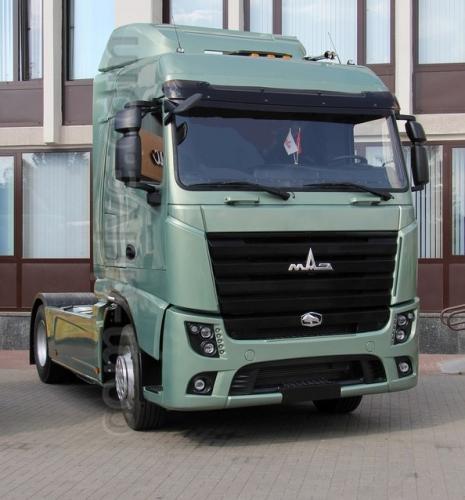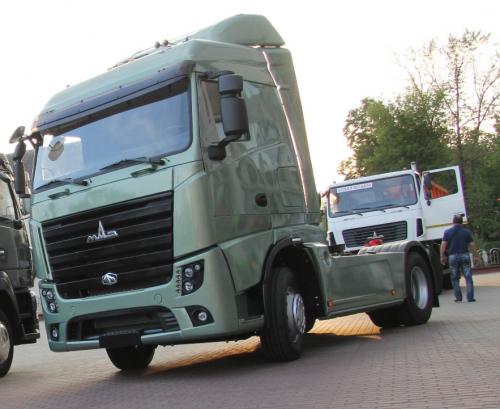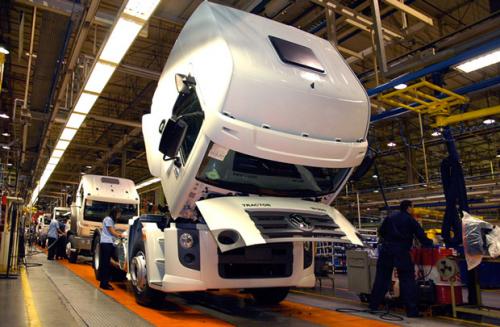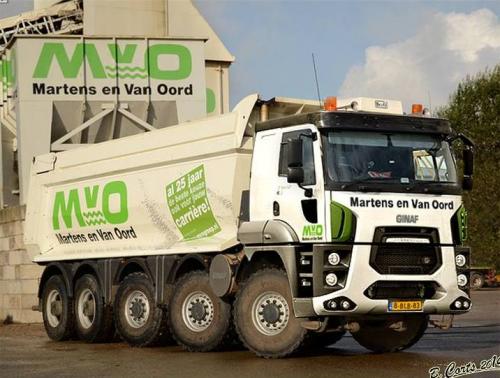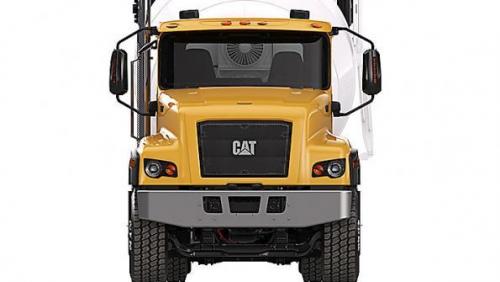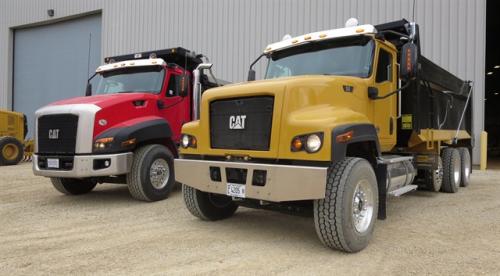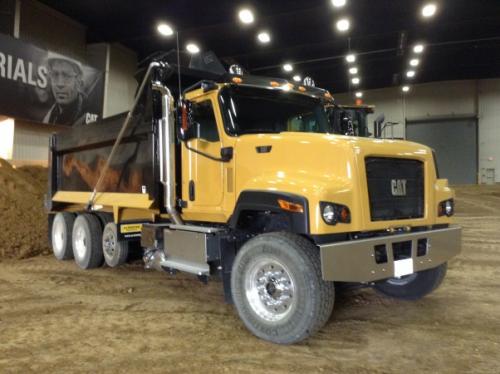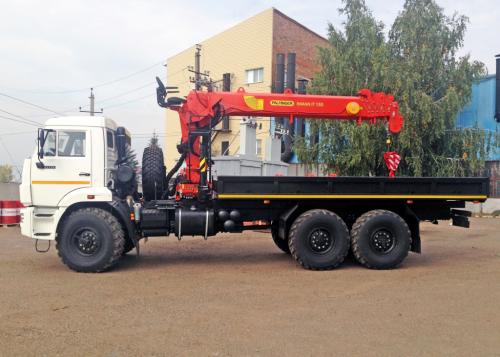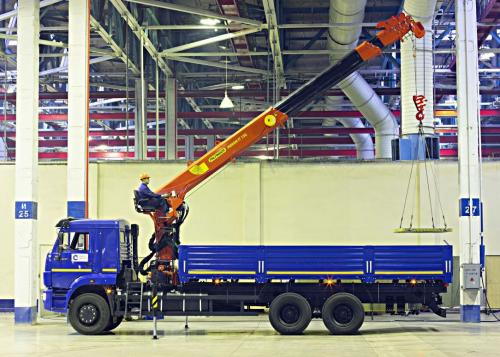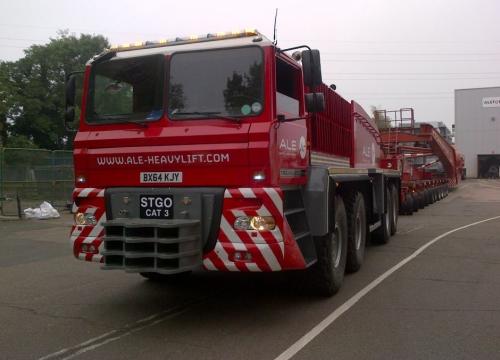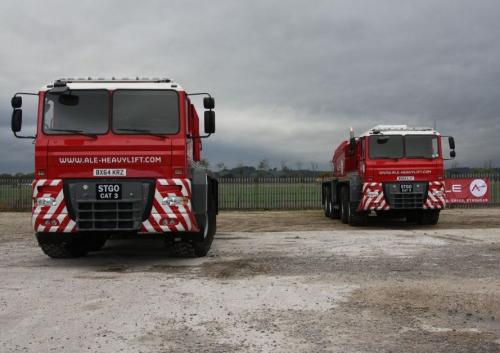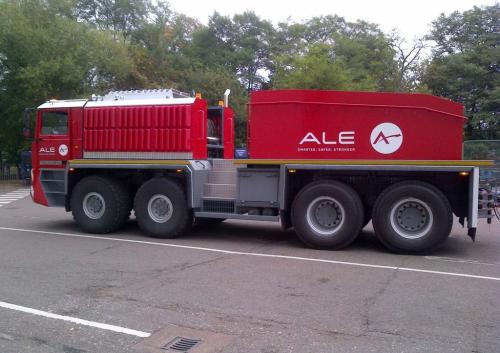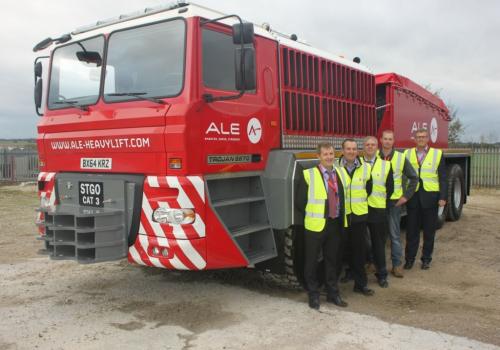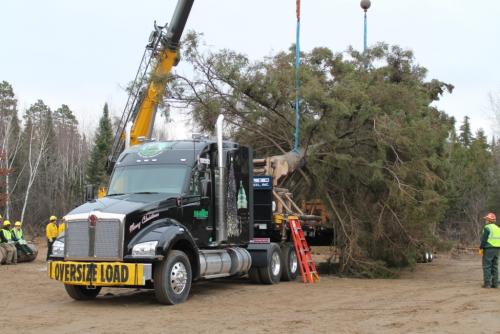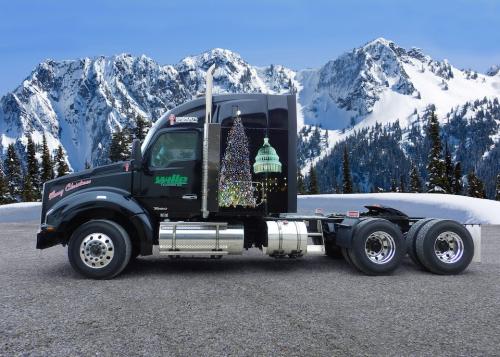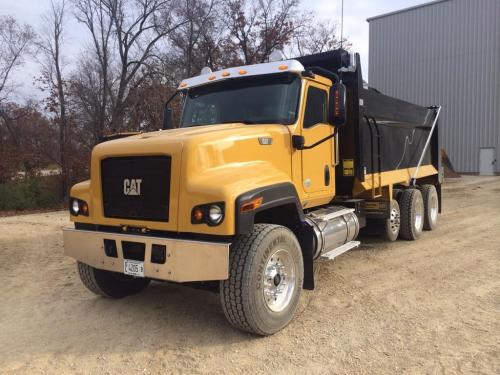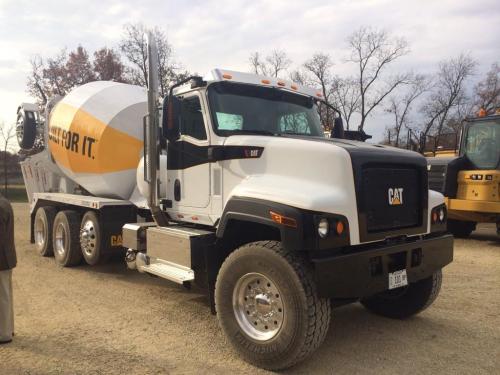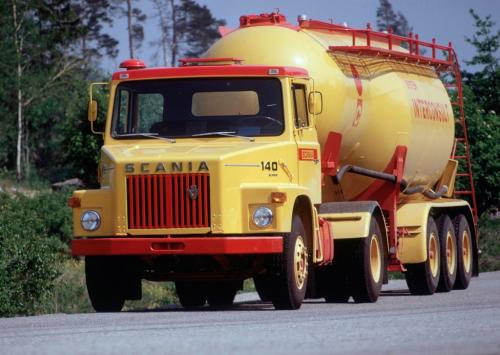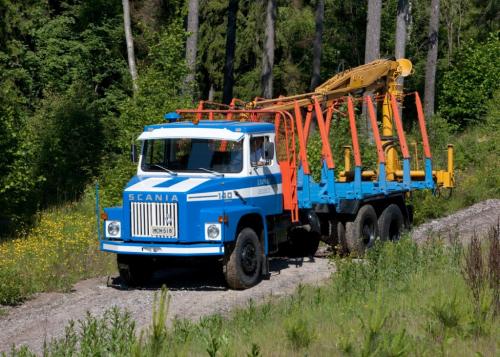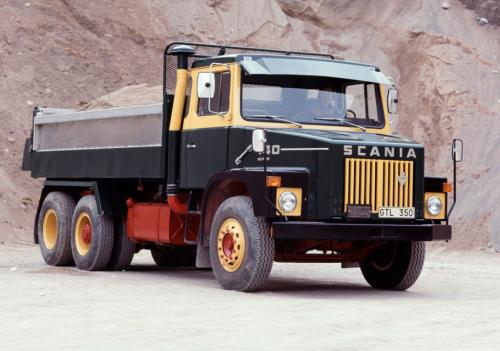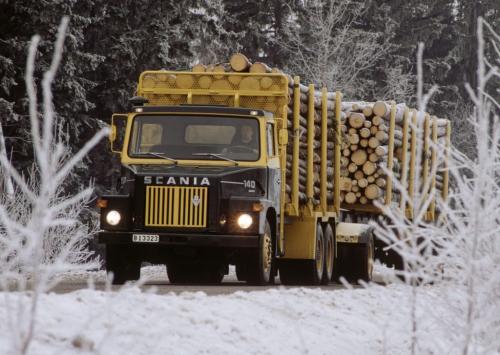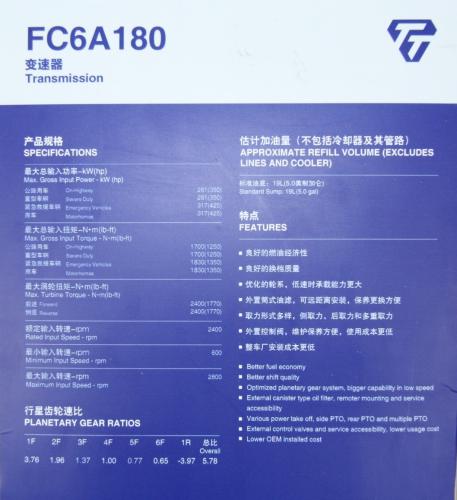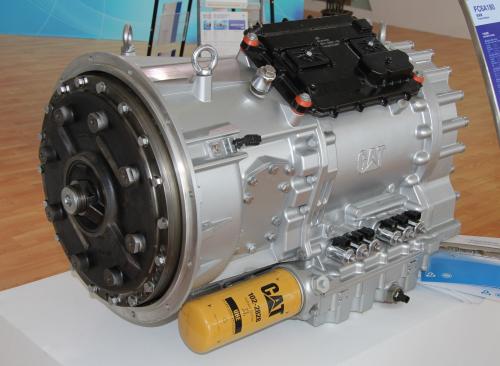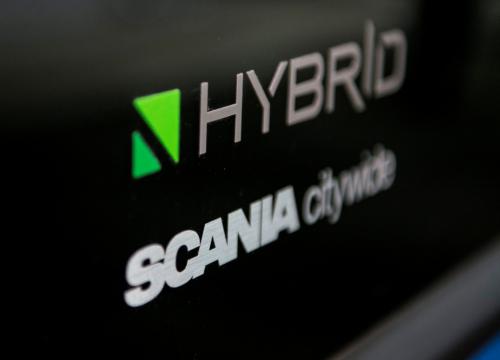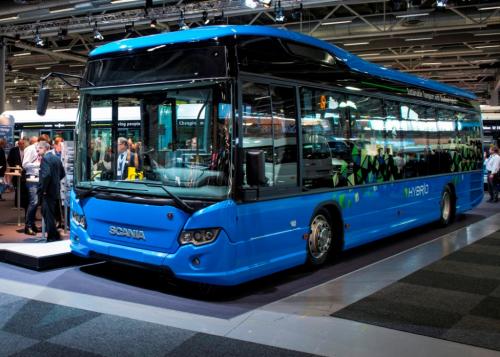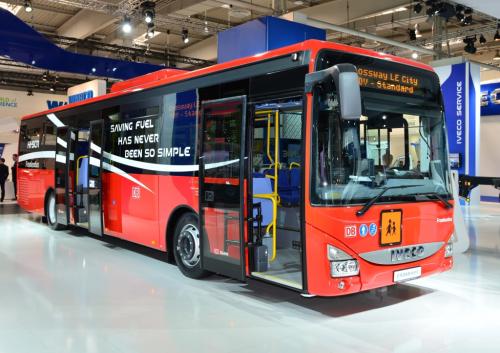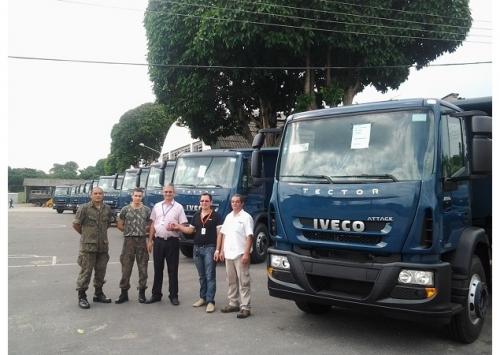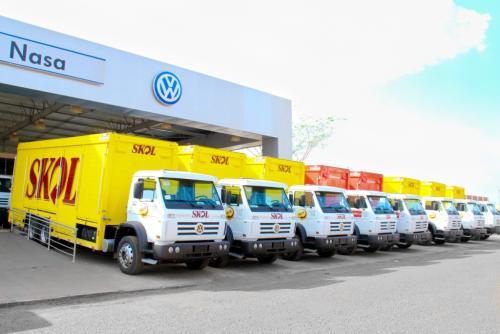
kscarbel2
Moderator-
Posts
18,892 -
Joined
-
Days Won
114
Content Type
Profiles
Forums
Gallery
Events
Blogs
BMT Wiki
Collections
Store
Everything posted by kscarbel2
-
Press Release / August 9, 2014 Belarus-based truckmaker MAZ has debuted an advanced new Euro-6 heavy tractor on the 70th anniversary of the Minsk Automobile Plant. The MAZ-5440M9 features a completely redesigned cab with a dramatically enhanced exterior complimented by significant interior upgrades. A low fifth wheel of 1150mm easily allows haulage of 2.9 meter height shipping containers and high-cube trailers. The 4x2 variant of the tractor has a gross combination weight rating of 40 metric tons (88,185lb). The new tractor is powered by the Euro-6 emissions compliant Mercedes-Benz OM471 (DD13) rated at 475 hp. MAZ finalized an OM471 engine supply agreement with Mercedes-Benz in 2013. MAZ chief designer Pavel Shabanov said of the new MAZ-5440M9 tractor: "We created it using the latest heavy truck technologies, including advanced frame, suspension, drivetrain and cab design." https://www.youtube.com/watch?v=ukoHHguIm0k .
-
Associated Press / November 3, 2014 Oshkosh subsidiary Pierce Manufacturing is recalling 135 fire trucks in the U.S. because a suspension part can fail and cause a wheel to fall off. The National Highway Traffic Safety Administration says the recall covers Pierce Arrow fire trucks from the 2010 and 2011 model years. The trucks have TAK-4 front suspensions and were built from Nov. 18, 2009, through May 11, 2011. The agency began investigating the trucks in March after getting reports of a wheel falling off two aerial ladder trucks that were responding to emergency calls in Portland, Oregon, and Edmond, Oklahoma. The Wisconsin-based company also told the agency of another case in Milwaukee. Pierce will inspect the lower control arms on the trucks and replace any that are defective. http://www.oregonlive.com/portland/index.ssf/2014/02/enroute_to_house_fire_in_south.html
-
Press Release / November 1, 2014 Volkswagen Group’s Resende commercial truck plant in Brazil is marking its 18th anniversary. Production of VW light, medium and heavy trucks, and bus chassis, moved into the then-new facility in 1996. Located just south of the coastal city of Rio de Janeiro, Resende began with 200 employees producing one truck per day. Today the plant employs over 5,000 people and is Resende’s largest private employer. VW commercial trucks are the market leader in Brazil, with over 680,000 units produced to date. Over the last 18 years, VW Group has continually reinvested in its commercial truck product and manufacturing capabilities. By 2017, the value will have reached US$1.6 billion, contributing to the enrichment of the region’s technological and economic growth. The plant has revolutionized the economy of Resende, generating employment and income. VW Group is responsible today for 65 percent of the municipal tax collections, what if reverts in direct improvements for the population on issues such as health and education. "Our size and growth in Resende has served to attract additional major vehicle manufacturers and supporting suppliers to the area. Our success in Resende over the last 18 years is very much due to the high quality local talent. We thus feel a very close relationship with Resende and region," says Roberto Cortes, president of VW Group’s VW truck-producing subsidiary MAN Latin America. The Resende plant has grown significantly over the years to allow the company to now produce 106 models of trucks and buses for both the Brazilian domestic and global markets. Originally 90,000 square meters in size, the facility has grown to nearly 180,000 square meters, including final assembly, the logistics center, supplier area and modifications center*. Another 20,000 square meters was just added in 2013 to place axle/suspension supplier Meritor and suspension supplier Suspensys within the complex. Resende was historically the world’s first vehicle assembly plant to locate suppliers within the facility. The now common practice is known in VW-speak as Modular Consortium, an arrangement in which each supplier assembles their module and provides on-line assembly of their module onto the vehicle. Suppliers have full responsibility for their assembly cells, from purchasing to inventory control, tool maintenance, quality, worker safety, wages and labor grievances. Production consists of eight modules including cab shell, painting, engine, cab grooming, wheels and tires, chassis and suspension. Cab shell AKC Aethra http://www.aethra.com.br/ Painting Carese http://www.eisenmann.com/en/about-EISENMANN/at-a-glance/locations/brazil-pt/build-operate-transfer-models.html Engine MAN / Cummins Cab grooming Continental http://www.conti-online.com/www/automotive_br_pt/themes/commercial_vehicles/ Wheels and tires Remon Chassis Maxion http://www.maxionsc.com/contagem/?lang=en Axles and suspension Meritor http://www.meritor.com/customer/southamerica/sa_products.aspx Suspension Suspensys http://www.suspensys.com.br/en Overall product quality control is the full responsibility of VW Group subsidiary MAN Latin America. Over the years, the production system at Resende has received significant technological updates including to 3D prototyping, scanners, laser cutting machines and a voice-commanded logistics system. In addition, a MAN of Resende Latin America maintains a manufacturing operation in the city of Querétaro, in Mexico, where it assembles Volkswagen-branded products for the local market. * Volkswagen Truck Modifications Center https://www.facebook.com/bmbmodecenter http://www.modecenter.com.br/ .
-
TTM / April 3, 2014 Netherlands-based specialty truck manufacturer GINAF has introduced a new model for the mining segment featuring a Ford-Otosan produced heavy truck cab and Cummins QSX15 engine. Whereas the standard HD5395 utilizes a DAF CF cab (and DAF-Paccar MX13 engine), the new HD5395TS is fitted with the Ford Cargo heavy truck cab. The model HD5395TS 10x6 features a steered tridem. Brazilian multi-national diversified metals and mining corporation Vale S.A., the world's biggest iron ore producer, has already placed an order for ten units for delivery in the first quarter of 2015. In off-road operation at speeds up to 40 km/h (25mph), the HD5395TS has a gross vehicle weight rating of 95 metric tons (209,439lb) and a rated payload of 70 metric tons (154,324lb). The Tier 3 emissions rated 14.9-liter Cummins QSX15 delivers 610 horsepower and 2,542 Nm of torque at 1400 rpm. The shifting profile of the truck’s 12-speed ZF As-Tronic automated manual transmission (AMT) is specially programmed by GINAF for the mining segment. A steel spring front suspension is paired with a electronically-controlled hydro-pneumatic vehicle suspension (HPVS) on the three rear axles. The first and second steer axles are rated at 13 metric tons (28,660lb), and axles three, four and five are each rated at 23 metric tons (50,706lb). Spec Sheet: http://www.ginaf.nl/uploads/media/HD5395TS_V1.5_grey.pdf http://www.bigmacktrucks.com/index.php?/topic/36862-custom-made-by-ginaf-the-worldwide-specialist-in-heavy-duty-trucks/ .
-
Transport Topics / October 31, 2014 Oshkosh Corp. reported its fourth-quarter net income more than doubled from a year ago as gains in commercial and access equipment sales offset a decline in military truck sales. Net income rose to $77.8 million, or 93 cents a share, from $36.3 million, or 41 cents, a year ago. Revenue for the quarter ended Sept. 30 slipped to $1.67 billion from $1.73 billion. The specialty truck maker’s operating income rose to $113.1 million in the quarter, from $65.2 million a year ago. Commercial sales rose 16.4% to $243.7 million and access equipment jumped 19.5% to $932.7 million. Fire and emergency sales fell 7.4% to $214.9 million and defense plunged 43.9% to $288.1 million. “Our access equipment and commercial segments led the way in fiscal 2014, with the access equipment segment surpassing last year’s record operating income margins by nearly 200 basis points,” said CEO Charles Szews. Its commercial segment posted its strongest full-year operating income margin since fiscal year 2007, which is “especially impressive because key end markets for both segments are still well below pre-recession levels, and we expect those end markets to grow in fiscal 2015 and beyond,” Szews said in a statement. For its full fiscal year, Oshkosh earned $309.3 million, or $3.61 per share, down from $318 million, or $3.55, a year earlier. Revenue declined 11% to $6.8 billion. Oshkosh said it expects fiscal year 2015 adjusted earnings per share $4 to $4.25 on projected sales of $6.5 billion to $6.6 billion, citing projected lower defense sales.
-
Fleet Owner / October 31, 2014 Caterpillar officially launched its CT681 Class 8 truck at a media briefing yesterday here at its Edwards Demonstration & Learning Center. The company said the new truck has entered full production-- and also revealed it will roll out another heavy-duty Class 8 next year. The second model in Cat’s on-highway vocational truck lineup, the CT681’s set-forward-axle design is aimed at fleets that must comply with bridge law formulas where they operate seeking to maximize their loads as well as those looking for a longer-wheelbase truck to gain better ride quality on long hauls or when running over rough roads, according to Ron Schultz, sales manager— Global On-Highway Trucks. The CT681 is offered only as a ‘daycab’ truck model with a 114-in BBC. Per Cat, that measurement “provides more room and flexibility to install bodies behind the cab.” By comparison, Cat’s first work truck, the CT660 that was rolled out in 2011, features a set-back-axle design and is offered with 116- and 122-in BBC lengths to “provide an extra tight turning radius for enhanced maneuvering.” Like its stablemate, the CT681 was designed and engineered by Cat and is built under contract by Navistar. Both trucks are powered by Cat CT Series vocational truck engines, which are based on Navistar’s MaxxForce SCR-equipped diesel powerplants. The CT681 is equipped with the Cat CT13 engine in ratings from 365-430 HP and 1,250-1,550 lb/ft peak torque. Transmission choices extend from Cat’s proprietary CX31 automatic transmission with six speeds plus reverse to Eaton manual and Ultrashift Plus vocational automated (AMT) models. Cat noted that the CX31 has been in use globally since 2004 and boasts the performance benefits of “full-power shifts and quick acceleration” as well as “ideal speed and torque combinations for improved fuel economy.” The automatic features two side PTO locations and a “Cat exclusive” rear PTO. Of the CT-Series trucks ordered so far, Cat said over 50% have been spec’d with its CX31 transmission. The CT13 engine was set up “specifically for vocational applications” and provides “optimum horsepower/torque combinations and the flexibility to match power and performance to specific jobs and operating conditions,” noted Cat. Engine features include a single electronic control module (ECM) and fewer electrical connections to help reduce diagnostic and maintenance time. Also, a fluid-free head gasket eliminates the risk of coolant leaking into engine oil or exhaust gases entering the cooling system. According to Cat, the CT681’s optional Front Frame Extension along with a front-engine PTO “makes it easy to mount attachments like snow plows, hose reels, winches and hydraulic pumps.” The company also pointed out that “mixer installation is also simple, thanks to vertical tie-in plates mounted behind the cab.” As for the truck’s “spacious cab,” Cat stated that it “combines the best of comfort and functionality,” including such key features as an ergonomic dashboard and center stack, tuned cab air suspension system, premium-grade sound insulation, combined standard and convex mirrors and an array of driver seat options. Safety-focused elements described by Cat include visibility by a curved, sloped, wraparound windshield (in one- or two-piece design); sealed-beam halogen headlights and LED park/turn lights; and large, heated, cowl-mounted mirrors with integrated turn signals. In addition, a “generous door opening, three-point grab irons and skid-resistant steps help ensure safe entry and exit” from the cab. The truck comes standard with Cat’s proprietary Product Link telematics system, which collects data from on-board systems and transmits it via satellite and cellular networks to a secure Internet site. Cat said using Product Link with its web interface, VisionLink, enables fleet owners to “access accurate, timely data about how, when and where trucks are being used.” Before the CT681 entered full production, it was put through extensive testing with North American customers as part of Caterpillar’s “field follow” program. The company said that testing amounted to the “equivalent of more than three years of heavy truck use.” Applications field-tested included snow plow, concrete mixer, dump and super dump. “This [testing] process provides a crucial feedback loop between our customers and our vocational truck product team, identifying any required changes to design and production,” said Dave Schmitz, product manager-- Global On-Highway Trucks. “Customers who have tested the truck tell us it drives well, it’s powerful, it’s quiet and their drivers enjoy getting behind the wheel,” he added. “Based on this feedback, we’re confident the CT681 is ready to handle whatever tough jobs our customers throw at it.” As for that next Cat truck slated for launch next year, Ron Schultz said it will be designated the CT680 and will feature a 124-in BBC, set-forward-axle design. He pointed out that the long-nose unit will be “offered as a truck or tractor and will boast unique styling that will set it apart from both the CT660 and CT681.” Schultz also advised that the upcoming CT680 was “designed based on extensive customer input” and is currently undergoing the same sort of filed-follow testing “throughout North America” that the CT681 did before full production ramped up. In terms of markets, Schultz noted that Cat’s on-highway trucks are now “fully in the U.S. and Canada and we’ve recently expanded into Puerto Rico and Mexico. And we’re looking to expand further regionally.” Regarding where else CT-Series trucks may be sold down the road, he told FleetOwner that “entering a market in a new country for us first requires understanding the laws and regulations” that impact how a truck is designed and engineered for customers there. .
-
Axle-Forward Cat CT681 Vocational Truck in Full Production
kscarbel2 posted a topic in Trucking News
Heavy Duty Trucking / October 31, 2014 Caterpillar has begun serving more vocational segments with its CT681, a Class 8 set-forward-axle model with “industrial” styling based on customer preferences, representatives said Thursday at a press briefing at Cat’s demonstration facility west of Peoria, Ill. The new model is aimed at dumper, mixer and snow-plow applications whose operators usually dispense with cosmetic frills and are more concerned with reliability and durability, said Dave Schmitz, product manager in Cat’s Global Truck Sales division. Its nose therefore lacks the brushed-aluminum grille trim of the CT660, the setback-axle version introduced in 2011 as the first model in the series. The new model’s set-forward steer axle makes it suitable for bridge-formula states, many in the West, that favor wide axle spacing to spread out weight. The steer axle’s center is 28 inches behind the bumper, which is flat to reduce the chances of faulty measuring by enforcement personnel, he said. Some operators believe a set-forward axle delivers a superior ride because it’s farther away from the driver. Parabolic leaf springs at the CT681’s steer axle, now also used on the CT660, allow for a smooth ride. The CT681 has a 114-inch bumper-to-back-of-cab measurement and comes only as a truck, whereas the CT660 is available as a truck and tractor. A third model, a long-nose CT680 with a 124-inch BBC and set-forward steer axle, is due out next year and also will come as a truck and tractor. Unveiled early this year, the CT681 is now in full production at Navistar’s plant in Escobedo, Mexico, Schmitz said. Navistar builds Cat Trucks based on the International PayStar but with enhancements specified by Cat. Among those is a nicely outfitted cab that includes deluxe trim, attractive and useful gauges, and wide rocker switches that can be operated with gloved hands. The cab also has round ducting pipes for efficient movement of air, which is filtered to keep out dust and other impurities. “My father and uncle were in the ready mix business in Milwaukee,” Schmitz said. “I remember it was always dusty – dust all over the place -- and noisy. So we took that into account in designing our cab” with the air filtration system and noice-reduction insulation. Mixer drivers must maneuver their trucks at job sites and need good visibility, so the cab has a large windshield and windows, he added. The CT681 is available with a front frame extension using long frame rails, along with a front engine power take-off, making it easy to mount snow plows, hose reels, winches and hydraulic pumps. Mixer installation is also simplified with vertical tie-in plates mounted to the frame rails behind the cab. Frame rails are 12 inches high for durability throughout an anticipated 10- to 12-year life, he said. The standard and only engine is the CT13, a Navistar N13 with selective catalytic reduction, that Cat has tuned for vocational duties. It has five ratings from 365 to 430 hp and 1,250 to 1,550 lb-ft. Cat’s CX31 6-speed torque-converter automatic transmission has been a popular option on the CT660, with more than half of all customers taking it, Schmitz said, and it’s expected to also sell well with the CT681. The CX31 includes a provision for a rear power take-off in addition to side mounts. Also available are vocational-type manual and UltraShift Plus automated mechanical transmissions from Eaton. UltraShifts are Vocational Service types with eight to 18 forward ratios. Like the axle-back CT660, the first model in the Cat vocational truck line, the new CT681 is backed by bumper-to-bumper service at more than 400 Cat dealer locations with over 2,300 service bays in North America. . -
Truck News / November 1, 2014 Caterpillar's new CT681 is a short nose, set forward vocational truck designed for use in Eastern urban environments. With its slab-fronted, unadorned styling the new Caterpillar CT681 won’t win any beauty contests, but that’s not its purpose in life. The truck is meant to be an urban, vocational workhorse and according to the company, every design element was created with that goal in mind. “Customers in the trucking industry aren’t bashful in telling you what they want. They were clear. They said, ‘I don’t want the fancy stuff. Give me something durable. Give me less pieces. Let me not worry about getting a scratch.’ It was a complete surprise to us,” said Dave Schmitz, global on-highway truck product manager. The CT681 is a short-nosed truck with a set-forward axle. It’s a truck that Caterpillar expects to see laden with dump beds, snow plows and cement mixers. It’s also a truck that should perform well in tight city environments, because of its axle positioning. “Your set forward, long nose truck is very popular in the West because of the comfort. It’s going to be found in a wider variety of applications from logging to bottom dumps and side dumps. The short-nosed is completely focused on the eastern market,” said Schmitz. The design In particular, operators who work in jurisdictions where there is a strictly enforced bridge formula are expected to make up a large market segment for this truck because of how it was designed, according to Caterpillar. “Customers told us with the short BBC (bumper-to-back-of-cab—114 inches in this case ) truck, make sure you hit bridge. And make sure you hit bridge easily. We asked ‘what does that mean?’” explained Schmitz. “When you have a bridge formula there is a lot of space to measure from that bumper to that centre line of the axle, which we call B2A, bumper to axle. It is typically designed for under 30 inches—29.5 inches. They said ‘we run into inspectors that don’t set up their measurements properly. Make sure you hit that formula.’ We brought it down to an industry best 28 inches We made sure that front bumper was flat. It had to be flat, so that they’re not taking their tape measure and putting it at the wrong spot on the bumper when they make that measurement, so the companies don’t get ticketed because of the opinion of how far the B2A is. “We also did small things like the tow hooks in the front. We made them flexible and able to be turned in so when the measurement is taken, the measurement from the front bumper doesn’t take into account the tow hooks. The two hooks either fold in or they are sitting on the side of the rail and you take them off and detach them when you are not in full load.” Not only does the front of the truck look flat because of the bumper, that aesthetic also comes about because of the placement of the radiator, and the vehicle’s structural design. “We said we have to hit certain features. We’ve got to be able to put a snow plow on the front. And keep the product durable. So we went with a 12 inch frame. We knew if we went to a 10 inch frame all we’re looking at is putting on more weight, more steel, etc., to keep that thing durable and reliable. Customers keep these trucks 10-12 years. With linehaul, it’s four to five, and then they turn them over to somebody else. [Vocational operators] want to run for a lot more years. We made sure the front frame extension off the front–that’s the amount you put the snow plow on—is integrated in rail. It’s not a bolt-on. Any time you bring in a joint you open up opportunity for durability challenges, so we made sure it was a true front-frame extension where the rails went right out through the front. By doing that we also had to have the radiator on top of the rails. On our CT660 we have a bracket that drops down below the rails into the radiator. You can have the nose be extremely sloped. On this one, we wanted to have the front frame rail extension so we put the radiator on top. So it’s all about function,” he said. “The grill needs to stay with the radiator so it opens up the access. We didn’t want to run the grill into the pump you have to put on the front, or in the case of a snow plow those linkages in the front too. Combine that with the requirement to keep not just the bumper but the front end flat, and you start stacking up those other things, it starts to complicate things. Not to mention the radiator we put above the rail–that played a little bit with the height. Customers say I have it covered up anyways when I put a snowplow on it, it makes no difference.” Additionally, by having the front frame rail extension, it gives Caterpillar the ability to include a front-engine PTO. According to Schmitz, one of the advantages of the way the front end was designed was that there is a lot of space in the engine compartment, making it easy for a mechanic to perform top-end overhauls or to change sensors, without having to pull the engine. The powerplant While there is a variety of engine configuration options on the CT681, there are also a number of common features that Caterpillar emphasized when presenting the truck. Schmitz spoke about not just the construction of the engines but also of some of their features. The base of all of the engines is what the company describes as a “compacted, iron graphic block” which Schmitz said not only saves about 200 lb. of weight, compared with a typical iron block, but also cuts noise by about 30% versus engines built with more traditional materials. “They have high pressure common rail fuel system with 32,000 PSI of fuel pressure. This gives you that natural burn, that better burn. It helps on both the power and on the emissions, as we have emission control devices on the truck. There are also dual turbo chargers, low side and high side, so when the engine is at a lower speed it is depending on one turbo. When it gets to a higher speed it depends on the other. Add that flexibility. You have that constant torque curve throughout the engine operation. “We do have an SCR system on the truck. It’s a highly efficient SCR system combined with recirculation. We do a nice combination, balance of the two, to make sure it is not consuming too much DEF, and to make sure we have the power. It’s a nice balancing act.” As far as transmissions go, again Caterpillar is giving buyers a choice, including Eaton UltraShifts, but the company’s preference seems pretty obvious: the six speed automatic CX31, which is integrated with the engine. “Since we have control of the engine and we have control of the transmission, we can have them talk together,” said Schmitz. “It is a full power shift. That means in between gears you still have power to the road. Automated manuals don’t have that. Other automatic transmissions don’t have that. You have constant power, so you are not wasting fuel, you are not having to recover and if you are up a hill with a heavy load, you have a nice smooth carry.” According to Schmitz, it’s not just Caterpillar executives and employees who like the CX31, so do more and more of the company’s customers. “I know on the Caterpillar truck line as of right now, over 50% of our trucks are going out with that CX31 transmission.” Brakes and suspension The CT681 offers paver brakes on the back and parabolic taper leafs (which are also now available on the CT660) that Schmitz says “give you that real nice ride, unloaded. When you do put a load on the front end, they are compressed and turn into a different style of shock. You’ve got a nice ride both when you’re unloaded and when you are loaded.” The interior Caterpillar said the cab in the CT 681 is essentially the same as the CT660’s cabin in terms of design, complete with storage caddies on the top of the dash and a clipboard/book slot in place of the glove box. The CT681 has a leather-wrapped, tilting, adjustable, telescoping steering wheel as standard, and the same wheel is in the CT660. New to the CT681 and also now available on the CT660 is an air filter designed to eliminate fine concrete dust from the cabin. Heated mirrors are standard equipment, so is what the company describes as a premium sound insulation package. Schmitz explained the instrument cluster features one large centre gauge that acts as both the speedometer and tachometer, “so when you’re driving you only have to look at one spot, you don’t have to look at two different spot. You look at one spot to see your speed and your RPM, especially for those trucks with manual transmissions.” Care, maintenance and monitoring All of the CT681s come standard with CAT’s Product Link telematics system. When paired with the company’s VisionLink Web interface, fleet managers will be able to monitor all aspects of the trucks’ operating conditions and are even able to set alerts if a truck has been moved outside of a prescribed boundary area. Alerts can also be sent to technicians or Caterpillar repair shops when engine codes appear, giving maintenance experts the ability to remotely diagnose what problems have occurred wth the vehicles. Schmitz added that while the trucks are available with extended warranties, buyers looking for specific warranties, based on their unique operating conditions, have the option of getting customized plans. Coming next year The CT681 isn’t going to be the only set-forward truck in Caterpillar’s vocational stable. Next year it is being joined by the CT680, a long nose, set forward. The CT680 will have as 124 inch BBC measurement and will be available as both a truck and a tractor (where the CT681 is truck only). “It’s going to be uniquely styled. It will not look like the 681 or the 660,” said Schmitz. .
-
Press Release / October 21, 2014 The joint venture company formed by Salzburg, Austria-based Palfinger and Russian truckmaker Kamaz, Palfinger-INMAN, has added the model IT-150 stiff boom crane to its offerings. The IT-150 is available factory-installed on Kamaz’s 65117 6x4 on-highway series, and 43118 6x6 on-off road truck range. The IT-150’s boom can extend to up to 19 meters (62ft) and has a maximum load rating is 6.6 metric tons (14,551lb). The turning angle is 420 degrees, and a maximum load lowering depth of 18.3 meters (60ft). Truck-mounted stiff boom cranes are in high demand on the lifting equipment market, because they have unique performance in delivering cargo to hard-to-reach locations. The IT-150 is also RUB 150,000 (US$3,581) less expensive than similar Korean products, making the new Palfinger design a serious competitor in the knuckle boom loader market. https://www.palfinger.com/ru/rus/Pressroom/novosti/corporativnie/2014/seriynoe-proizvodstvo-novogo-trosovogo-krana-palfinger-inman-it-150-na-baze-shassi-kamaz-65117-i-43118 .
-
Press Release / October 14, 2014 UK-based specialist heavy lift and haulage contractor ALE (Abnormal Load Engineering) has begun production of the Trojan 8870. The truck was designed by the company's engineers and is being produced at its operational hub at Hixon. ALE says the Trojan 8870 represents a breakthrough in capability, fuel efficiency and reliability. The 8870 model designation reflects the truck’s 8x8 configuration and 700 horsepower powertrain. The development of the new prime mover vehicle was part of a truck replacement process conceived some time ago, and the new vehicles are based on a concept initially developed in 2012. Gary Butler, ALE project manager and designer of the Trojan said: "We wanted to replace our current fleet of trucks with a specification that improved on vehicle performance, capability and fuel efficiency but there was no other truck on the market that delivered this. "We therefore designed our own based on our specific requirements which included computer synchronization, future-proof electronics, automatic gear change, ABS, transmission retardation, a good footprint for power and torque, and a stainless steel cab. "Through the custom drive and transmissions, we are now able to deliver the required power to move abnormal loads more efficiently, more smoothly and in a more environmentally friendly way." ALE says that one of the special features of the Trojan's design is its ability to link up multiple tractor units in a 'command and drone' convoy, whereby the command vehicle is able to control itself, as well as any other tractor units in the convoy, through mechanical and air links, as well as an electronic Can Bus System. Vehicle braking, electrics, engine and transmissions on all tractor units are synchronized by computer which ensures each vehicle is in a matched gear, matched RPM and matched torque. Vehicle braking, engine compression braking and transmission retardation can be controlled identically and there is no limit to the number of vehicles that can be added to the convoy. These features help to deliver a smoother ride through the whole length of the convoy, thereby reducing potential stress on any consignment being transported. The Trojan truck's design weight is 72 metric tons (158,733lb) and it has a maximum geared road speed of 48 mph (77 km/h). It can pull a gross combination weight of metric 300 tons (661,387lb) at its maximum gradient of 14 percent, although this weight capacity can be increased as the incline is decreased. A bespoke engine and transmission performance reduces emissions and provides a fuel saving of 40 percent compared to that achieved by previous models. A further important design consideration for ALE was to ensure that power could be delivered effectively, producing significantly improved tractive effort compared to other standard market products. Critical to this was to ensure that the trucks provided a significant and balanced footprint which would also assist with retardation. These are the first of a fleet of six new Trojans to be built by ALE, with delivery of all six by the end of next year. Four will be retained for use by the company in the UK, with two destined for the company's subsidiary in the United Arab Emirates. Trojan 8870 Specifications Gross combination weight 300 tons (661,387lb) at a gradient of 14% fully loaded Maximum geared road speed: 48.mph / 77.km/h Design weight 72 metric tons (158,733lb) 1st Axle 12,000kg (26,455lb) 2nd Axle 12,000kg (26,455lb) 3rd Axle 24,000kg (52,911lb) 4th Axle 24,000kg (52,911lb) Engine: Volvo Penta TAD1662VE, 6-cylinder inline, Euro-5, turbocharged and intercooled, 700hp (515kW) at 1,800 RPM, 3,220 Nm torque at 1,200 rpm, Water cooled, Ambient range -31ºc to +55ºc. Main transmission: Allison M6620AR full automatic 6 speed. Integral torque converter, PTO, & retarder. Auxiliary Transmission: Kessler VG2500, 2 speed transfer case, with built in torque proportioning 1/3 to the front 2 axles, 2/3 to the Rear 2 axles. Low range = 2,07:1 / High range = 1,03:1 Front axles: Dana twin steer, bevel hub reduction type, Inter-axle & cross-axle differential locks. Front suspension: slipper-ended semi elliptic parabolic leaf springs with heavy duty hydraulic telescopic dampers. Rear axles: Kessler manufactured tandem, spiral bevel, hub reduction, 25,000kg (55,116lb) capacity per axle. Pneumatically operated inter axle & cross axle lockable differentials. Rear suspension: Hendrickson 48 ton (105,822lb), 6-rod, twin high articulation semi-elliptical, multi-leaf springs, trunnion mounted. Braking system: All axles, duel circuit, ABS, S-cam drum type, with emergency spring brakes, & parking brakes on all axles. Compressed air operated via heated air dryer to service & secondary reservoirs, High output auxiliary compressor, hydraulically controlled. Front tyres: Michelin XZL 24R21 on / off road singles. Rear tyres: 1400R25 twin assembly Steering: Integral power box with direct operating drag links and hydraulic rams, plus emergency backup. Cab: Penman, 2mm stainless steel, corrosion resistant walk through military cab with seating for 2 persons. Heating, aux night heater, and air conditioning as standard. Electrics: 24 volt Winch: Single 8,000kg (17,637)) hydraulically driven horizontal drum. Fuel capacity: 1,400 litres (370 U.S. gallons) http://www.ale-heavylift.com/news/ale-unveil-first-trojan-truck/ http://www.ale-heavylift.com/wp-content/uploads/2014/10/14_24.10.14-Trojan-Trucks-Press-Release.pdf .
-
Press Release / October 23, 2014 T880 To Transport Special Tree To More Than 30 Community Celebrations en route to Washington, D.C. A special Kenworth T880 undertakes an important mission this fall - transporting the U.S. Capitol Christmas Tree to more than 30 community celebrations before a final stop for setup, decoration and the tree-lighting ceremony in Washington, D.C. As part of its tour efforts, the Kenworth T880's distinctive decal design was unveiled today in advance of the 2014 Capitol Christmas Tree-cutting ceremony Oct. 29 near Cass Lake, Minn. The Kenworth design features a night shot of the U.S. Capitol, brightly lit and colorfully arrayed Christmas tree, official seal of the 2014 Capitol Christmas Tree project, and logo of Wille Transport, a long-time Kenworth customer based in Cohasset, Minn. During the tour, two Wille Transport drivers will pilot the Kenworth T880 and a Kenworth T680 Advantage on a journey of nearly 2,000 miles. The T880 is Kenworth's flagship heavy haul vocational truck equipped with a comfortable 52-inch mid-roof sleeper, powerful and fuel-efficient 500-hp PACCAR MX-13 engine with 1,850 lb-ft of torque, and reliable Eaton Fuller 13-speed transmission. The T880 will pull a trailer specially designed for the Capitol Christmas Tree - a nearly 80-foot white spruce from Minnesota's Chippewa National Forest and the Leech Lake Band of Ojibwe. Another 70 Christmas trees, donated by Minnesota Tree Growers Association, will be transported by the fuel-efficient Kenworth T680 Advantage with 76-inch sleeper, Eaton Fuller Advantage™ 10-speed automated transmission, Diamond VIT interior Kenworth Idle Management System, and Kenworth's new, factory-installed aerodynamic package. The T680 Advantage offers an ultra-aero spec to provide the very best Kenworth model for fuel economy. Those trees will be used to decorate the inside of the U.S. Capitol building and other federal sites throughout Washington, D.C. The T680 Advantage also will bring 10,000 ornaments created by children and others from Minnesota communities to adorn the Capitol Christmas Tree and the smaller trees. "The annual lighting of the U.S. Capitol Christmas Tree is a true American tradition. It is a special honor for Kenworth to participate in this year's 50th anniversary Capitol Christmas Tree tour," said Kurt Swihart, Kenworth marketing director. "The T880 heavy hauler is engineered with the proper specs to handle this important move, and the graphics are a tribute to the tree's destination." The tour's first stops are at the Itasca State Park and Bemidji in Minnesota Sunday Nov. 2. A complete tour schedule and additional information may be found at the 2014 U.S. Capitol Christmas Tree web site (www.capitolchristmastree.com) so the public can track the truck's progress. http://www.kenworth.com/news/news-releases/2014/october/t880-capitol-christmas-tree.aspx .
-
Commercial Carrier Journal (CCJ) / October 30, 2014 Caterpillar added a second model to its new line of vocationally focused work trucks with the unveiling of the Class 8 CT681 truck Oct. 30 at the company’s Edwards Proving Grounds outside of Peoria, Ill. Caterpillar first previewed the new truck at the ConExpo Show in Las Vegas earlier this year. The Edwards launch today gave enhanced details on new truck while noting it has entered into full production. The CT681 borrows heavily from the existing CT660 model, but features a host of enhancements designed specifically for tough vocational applications such as snowplow, mixer, dump and super dump. The truck features a set-forward front axle for a longer wheelbase with a 114-inch BBC measurement. Caterpillar’s global on-highway product manager Dave Schwartz says this configuration offers better ride quality on both long hauls and rough dirt roads while giving body-builders more flexibility and room for behind-the-cab installations. Power is provided by Cat’s CT Series Vocational Truck Engine family, with several ratings from 365 to 430 horsepower available. Schwartz says Cat’s truck engine philosophy is “still evolving,” but says additional, higher horsepower ratings will appear in the near future. It is possible this could be as early as next year, coinciding with the launch of the next Caterpillar truck, the CT680, which Schwartz says will be a stylistic departure from the CT660 and CT681. The CT681 has already made a move away from the CT660 in terms of appearance. The new truck features a more robust, spartan look. The wheel loader-inspired, brushed aluminum grill guard and trim that give the CT660 such as distinctive look have been abandoned on the CT681. Schwartz says this move was necessary to accommodate the CT681′s new, higher, radiator configuration and simplify front engine PTO access. The CT681′s engine can be spec’d with Cat’s proprietary CX31 automated manual transmission. Schwartz says that today, more than half of all new Cat trucks are rolling off the factory floor with the CX31 AMT, which features a high power-to-weight ratio, full power shifting and quick acceleration. The transmission has been fully integrated with the CT Engine series to deliver optimal fuel economy or power to meet any type of terrain or road conditions. .
-
Fleet Owner / October 30, 2014 Ron Schultz, Cat's sales manager-global on-highway trucks, provides an overview of OEM's new axle-forward CT681 Class 8 truck model. The CT681 is now in production and is the second model in Cat's on-highway truck line, the other being the CT660 axle-back configuration rolled out in 2011. Video: http://fleetowner.com/equipment/caterpillar-vocational-truck-overview
-
Press Release / October 30, 2014 Up until the 1970s, Scania’s powerful DS14 V8 engine had only been mounted in cab-over-engine (forward-controlled) trucks. But there was market demand for more-powerful bonneted trucks, not the least among forestry transport companies. The new 14-litre V8 engine achieved significant success with its 350 hp of power, an impressive figure for the time. The engine was initially mounted only with forward-controlled cabs. But there was strong market demand for bonneted trucks. Most European competitors had ceased making bonneted trucks, but Scania decided to build this style of vehicle using the new V8 engine. An all-round forest vehicle Construction on the bonneted models, which were called the L140 and the LS140, began in February 1972, two and a half years after the appearance of their forward-controlled predecessors. The new conventional cab design was developed from Scania’s COE cab, with a high level of interior comfort and ample room for drivers, something which up until then had been uncommon in bonneted trucks. It was primarily forestry transport companies that wanted bonneted trucks, as it felt safer to have the motor in front of the driver on narrow, icy roads. But the new L-models also became popular vehicles for construction, heavy haulage and towing applications. A total of 1,653 L 140-series vehicles were produced between 1972 and 1976. . FYI: The Scania DS14 V-8 was based on the Mack ENDT865/866. Mack introduced the 14.2 liter ENDT865 in 1969, the same year Scania introduced the 14.2 liter DS14. Scania used an individual cylinder head design (favored in Europe at the time), while Mack used a two-cylinder head design (four heads total). The DS14 was 14.19 liters, while the Mack ENDT865/866 engines were 14.17 and 14.19 liters respectively. .
-
Weichai Group / October 29, 2014 Despite a slow beginning, Caterpillar’s joint venture with Chinese transmission manufacturer Fast Gear is beginning to see demand for its CX28 and CX31 transmissions from fire apparatus manufacturers. In recent years, Allison has been the principle supplier for the small but growing percentage of fire and rescue vehicles equipped with automatic transmissions. In the global market, the CX28 is rated up to 400hp and 1250 lb-ft (1695N.m), while the CX31 is rated up to 600hp and 1850 lb-ft (2510N.m). Based on the CX28 and CX31 respectively, the following six-speed models were launched by the joint venture in 2013: Model Rating FC6A80 221hp / 590 lb-ft (800N.m) FC6A100 268hp / 740 lb-ft (1003N.m) FC6A140 338hp / 1055 lb-ft (1430N.m) FC6A180 425hp / 1350 lb-ft (1830N.m) FC6A210 510hp / 1605 lb-ft (2176N.m) FC6A250 625hp / 2000 lb-ft (2576N.m) In America, only Navistar and CAT-branded trucks have offered the CAT CX Series automatic transmissions as a factory option. During the 2007-2009 period, the smaller CX28 was offered in recreational vehicles equipped with CAT C7 and C9 engines. “For decades Caterpillar has been building planetary transmissions for its construction equipment,” said Chris Schena, Caterpillar vp- Motion and Power Control Division. “We are now leveraging this expertise and applying it specifically to the transmission needs of on-highway customers.” “We’re not trying to run Allison out of the business,” says Larry Riekert, On-Highway manager, Caterpillar OEM Solutions Group. “We believe that automatics will be a growing percentage of total sales and we feel our sales will go up while [Allison’s] go up. What we’re seeing now is that the rate of conversion of manuals to automatics is increasing. Of course, Allison might not see it that way.” Fleet Owner – December, 2005 Established in June 2011, Xi'an FC Intelligence Transmission Co., Ltd. is a joint venture company between Caterpillar and Shanxi Fast Gear Co., Ltd. The company manufactures drivetrain systems and other components for CAT construction machinery, as well as CX28 and CX31 on-highway automatic transmissions for the Asian market. .
-
Press release / October 29, 2014 With the launch of the new hybrid-powered Scania “Citywide” low entry bus, Scania takes another step towards offering carbon neutral transport solutions. In line with Scania’s leadership in biofuels, the new Euro-6 hybrid powertrain runs on up to 100 percent biodiesel. The SCR-only Euro 6 engine is already low on fuel consumption, but the parallel hybrid system provides impressive additional fuel savings. And unlike other hybrids, the system is optimised for city and suburban operation and allows speeds up to 100 km/h (62mph). “The bus and coach business is highly cost-conscious and needs to meet the highest environmental standards,” says Klas Dahlberg, Senior Vice President Buses and Coaches, Scania. “We have taken that to heart and developed outstanding products that combine the best performance in both respects.” Scania developed hybrid technology Scania has been running trials on hybrid technology for more than two decades. And the robust parallel hybrid concept that has now been launched in the Citywide buses is a comprehensive response to customer demands that provides attractive payback times. It will be produced in large volumes for both trucks and buses and will receive full service coverage via the worldwide Scania service network. The new hybrid system is part of Scania’s modularised range of powertrains that powers both buses and trucks in an immense range of combinations. It is also part of Scania’s long-term strategy for powertrain electrification for both trucks and buses. Two different lengths to start with The hybrid system is initially being offered on 12- and 14.8 m buses with two and three axles respectively. The buses have a low-entry layout that offers several sustainable opportunities. They can be specified to work comfortably in the city, as well as on suburban and medium-distance routes. The hybrid powertrain includes the Scania 9-litre engine, in 250, 280 or 320 horsepower ratings, the latter with SCR-only technology and compatible with up to 100 percent biodiesel. On the Citywide buses, the hybrid unit, comprising an electric machine (motor and generator) and automatic clutch, is located between the engine and transmission. The electric machine is rated at 150 kW. 1,050 Nm. 1.2 kWh of energy storage is provided by a lithium-ion battery integrated in the roof structure at the front of the bus and is housed in a neatly styled bulb together with a DC/DC voltage converter and a cooling unit. High efficiency The use of a Scania hybrid system together with a DC/DC converter, stop-start function and hybrid eco-roll provide fuel savings of 20-25 percent, or 1.2-2.5 litres (0.32-.66 U.S. gallons) per hour of operation. The combined fuel and the use of biodiesel (320 hp version) provide CO2 savings of 60-65 percent, a uniquely high figure for Euro-6 hybrid buses. “The bus stands on its own merits, designed to make money for operators without the helping hand of public subsidies,” says Mikael Arhusiander, Product Manager City and Suburban Buses at Scania. .
-
Press Release / September 25, 2014 A new gas bus for city or BRT* routes has been created by Scania in cooperation with Belgian bus body builder Van Hool. Operated on either biogas or CNG the new bus offers a unique combination of capacity and low environmental impact. As well as being energy efficient, the Scania-Van Hool city bus also offers a light and spacious interior with an eye-catching articulated body that is reminiscent of a tram. It therefore combines the best of both worlds: the image and efficiency of a tram with the flexibility and cost levels of a bus system. ”It features a futuristic design and an interior that is light and airy to give the passengers a comfortable feeling inside. This way we hope to attract more people to the bus,” says Jan Van Hool, Executive Director at Van Hool. Camilla Lood, Product Manager Sustainable Solutions at Scania says: “Scania has joined forces with the respected Belgian bus builder Van Hool to create one of the most impressive and low impact vehicles ever seen in the public transport market. The design has been well received in large cities Europe-wide, forming part of BRT systems or smaller scale bus systems and boosting the image of public transport.” Scania believes in sustainability Scania believes that bus transport is paving the way for better transport sustainability, while also providing instant gains for passenger transport and for society. The new Scania-Van Hool city bus is a good example of this concept; having been created in line with Scania’s sustainability strategy. The articulated design offers exceptional passenger appeal, with a light and spacious low-floor interior and four double doors (2-2-2-2) for convenient entry and exit at stops. Operating as a modern looking and environmentally sustainable city bus, it is a guaranteed image-booster for public transport and can contribute positively to urban planning. The system lends itself to easy re-planning and re-routing, which is a great advantage in an expanding urban area and the choice of renewable fuels addresses CO2 emissions with immediate effect. The system can also be up and running rapidly and at a highly attractive cost. Bus systems competitiveness For passengers, a bus system opens a pleasant, reliable, cost-efficient and safe way of commuting. With attractive styling, easy access and high comfort, it has what is takes to win over passengers from car travel. Scania’s Euro 6 gas engine, which operates on natural gas or biogas, is mounted transversely at the rear and is renowned for its high efficiency and low consumption. The engine is rated at 320 hp and 1,500 Nm of torque available already at low engine revs, giving outstanding driveability for a gas engine. * BRT (Bus Rapid Transit) is an innovative, high capacity public transit solution at significantly lower cost than light rail. The concept uses buses or specialized vehicles on roadways or dedicated lanes to efficiently transport passengers to their destinations. BRT combines the capacity and speed of light rail or subway with the flexibility, lower cost and simplicity of a bus system. http://www.youtube.com/watch?v=8rT9hhfR3u4&feature=youtube_gdata
-
Press Release / September 25, 2014 Germany's largest bus transport company, DB FuhrparkService GmbH has ordered 710 Crossway Series municipal transit buses. Under the sales agreement, DB Regio will receive 400 Crossway and Crossway LE (Low Entry) city buses, to be delivered in 2015 and 2016. In addition, another 310 units will be delivered in 2017 and 2018. Factors leading to the sale included the advantageous total cost of ownership and reliability of Iveco Crossway buses which are already a part of the current DB fleet. “We are very proud to have the renewed confidence of Deutsche Bahn, which is further demonstrated by this significant order for our best-seller Crossway bus”, said Sylvain Blaise, Head of Global Bus at CNH Industrial. DB Regio Bus is responsible for operating Deutsche Bahn’s regional bus routes and suburban transport operations. It has a network of 22 bus companies and a stake in more than 70 private and municipal public-transport entities in Germany. “We carry about two million passengers a day on our buses. These customers are going to benefit directly from our investment. We are offering them vehicles that are modern, environmentally friendly and safe”, says Dr. Rüdiger Grube, Chairman & CEO of Deutsche Bahn. Customers, drivers and passengers will benefit from the new model thanks to its improved visibility, lower internal noise levels, storage space and a more comfortable environment. EBSF/VDV The Euro-6-compliant (EPA2010) Crossway LE series features new, wider doors. The design of the driver’s cockpit follows EBSF* and VDV** 234 international guidelines, providing increased comfort, accessibility and safety. It guarantees that, regardless which vehicle type, drivers will always find the controls and switches in the same place and experience the same ergonomic qualities. The entire Crossway range benefits from fuel efficient engines with Iveco’s HI-SCR emissions technology. This SCR-only after-treatment system functions without the use of EGR (exhaust gas recirculation) and carries a significant advantage in weight reduction and compactness for easy maintenance. * The European Bus System of the Future (EBSF) was the biggest road-related transportation project to date funded by the European Commission. The project involved four years of work, 48 partners, 7 demonstration projects and a total budget of US$32.7 million. A comprehensive, widely networked research project for the design and development of an innovative, high-quality European bus system of the future, the EBSF project took on the goal of demonstrating the capabilities of a new generation of urban bus networks and creating the basis for an integrated systems approach (vehicle, infrastructure, technology, operation) with takes future passenger requirements into account. EBSF aimed at developing a new generation of urban bus system adapted to the specificities of European cities. EBSF acted therefore as a driver to increase the attractiveness and raise the image of bus systems in urban and suburban areas, by means of developing new technologies on vehicles and infrastructure in combination with operational best practices, and testing them in real operational scenario within eight European cities. ** VDV (Verband Deutscher Verkehrsunternehmen) The Association of German Transport Companies .
-
Icarros Trucks Brazil / October 29, 2014 Iveco Brazil has delivered a fleet of Tector Series model 170E22 medium-heavy trucks to Brazil’s air force. The trucks will be fitted with a variety of bodies for airport operations. "The Tector “Attack” Series meets the air force’s requirements for a versatile COTS (commercial off-the-shelf) platform that offers low maintenance costs and robust design. The deal further strengthens our ties with the armed forces, "says Paul Goddard, commercial director at Iveco Brazil. . With two Exchange options and four different options of clearances, allowing a total of 16 versions, the Iveco Tector we versatility. http://www.iveco.com/Brasil/collections/technical_sheets/Documents/Iveco_Tector_Attack_170E22_bx.pdf http://www.iveco.com/brasil/produtos/pages/tector_carac_bene.aspx .
-
Press Release / October 28, 2014 To support growing sales in Brazil’s Midwest, AmBev distributor Lima Logics and Distribution will take delivery of another batch of Volkswagen Worker Series 23.230 “Distributor” beverage trucks to its fleet which serves 34 cities. The trucks will deliver beverage brands including Pepsi, Brahma, Skol, Gatorade and Bohemia. The 6x2 straight trucks are equipped with 225 horsepower MAN D08 engines which meet Brazil’s Euro-5 (EPA2007) emissions standards using MAN’s EGR technology. The trucks are prepped at the factory for body installation to In a competitive market, Volkswagen’s 23.230 6x2 Worker “Distributor” line-up is designed for urban and regional operations, offering robust construction, durability and low maintenance costs. "The beverage industry demands a robust truck chassis with high levels of agility, combined with low body heights for ease of access. These trucks add technological innovations and safety, making driving easier and more comfortable, improving productivity, with durability and low operating costs,” said Ricardo Alouche, vice president of sales marketing and after-sales support at MAN Latin America. http://www.man-la.com/produtos-volkswagen/vocacionais/caminhoes/distributor .
-
Fleet Owner / October 29, 2014 The Houston-Galveston Area Council (HGAC) is hosting a Drayage Truck Event at the Port of Houston on Saturday, Nov. 1, from 10:00 a.m. to 1:30 p.m., to share information about available grants and loans to help truck owners replace older vehicles with new, cleaner ones. According to the group, funds that could cover up to 80% of the cost of a new truck are available. HGAC has worked in the past with the Environmental Defense Fund (EDF) on emissions reduction efforts. The original Houston Drayage Loan Program replaced 200 of the more than 3,000 drayage trucks at the port.
-
Report Projects Decline of U.S. Diesel Demand After 2015
kscarbel2 replied to kscarbel2's topic in Trucking News
I long imagined this was going to happen, diesel demand peaking around the 2015-2017 period and then beginning a gradual fall, owing to reduced demand resulting from more efficient powertrains. This throws the whole viability of natural gas-powered trucks into question. -
Transport Topics / October 29, 2014 Higher vehicle efficiencies and the growing use of compressed natural gas in heavy-duty vehicles will lead to a decline in U.S. diesel demand beginning in 2016, according to a report released Oct. 29. Those changes will “more than offset a substantial increase in the number of diesel-powered light-duty vehicles in the market,” said the report by the PIRA Energy Group. The study, “An Assessment of the Diesel Fuel Market: Demand, Supply, Trade and Key Drivers,” was commissioned by the Fuels Institute with funding from the Natso Foundation, the research and public outreach subsidiary of Natso Inc., a trade group that represents truck stops. U.S. diesel demand is expected to drop 12.5% from a near-term peak of about 4 million barrels per day in 2015 to 3.5 million bbd in 2030, the report said. Diesel demand will be strongly affected by new fueling options, shifts in fuel usage and improved efficiencies, in both light- and heavy-duty applications, and in industrial applications, it said. “Changing consumer demand for diesel fuel will have a significant effect on fuel retailers and the U.S. economy,” Natso Foundation President Lisa Mullings said. “This report will help truck stops and travel plazas develop a sound strategy for optimizing these market changes to lead the fuel retailing industry into the future,” she added. The report is available for download at www.fuelsinstitute.org.
-
Automotive News / October 29, 2014 Penske Automotive Group Inc. wants to grow by snapping up more car dealerships overseas and buying other businesses, such as heavy-duty retail truck stores. Penske said today it agreed to raise its stake in The Around The Clock (ATC) Freightliner Group, a “heavy-duty retail truck dealership group” in Texas, Oklahoma and New Mexico. Penske said such businesses are attractive because they provide strong revenue with lower costs. CEO Roger Penske, in an analyst conference call today, said: “When I look at the commercial vehicle business, 70 percent of the total gross profits are from parts and service. So less capital is involved. It’s a more stable business, and there are not the facility requirements, such as the tiled floors and fancy showrooms,” that many automakers require. He said his company is spending $150 million a year largely on car dealership renovations that manufacturers want. Penske said he also is monitoring a no-haggle pricing program being tested at Toyota of Surprise in Surprise, Ariz. He said he is a “long, long way” from deciding whether or not to take the process to all of the company’s 244 U.S. dealerships, but it is successful so far. He said using one salesperson from start to finish is a cost saver. “The business has grown nicely,” Penske said. “We’re seeing our margin, based on one price, is competitive in the marketplace.” Earlier today, Penske Automotive reported that its third-quarter net income rose 15 percent from the year-earlier period to $75.1 million on strong new- and used-car sales aided by robust business at its U.K. dealerships. Revenue increased 18 percent to $4.42 billion. Revenue rose at a double-digit pace in all categories: new- and used-vehicle sales, fleet and wholesale sales, service and parts, finance and insurance operations and commercial vehicle, car rental and others. Knocking on doors Roger Penske envisions 60 percent of Penske Automotive Group’s revenue coming from its U.S. operations and 40 percent coming from various international holdings. That’s close to where it is now. He wants the company’s vehicle business revenues to grow 5 to 10 percent over the next two years. “The vision is to grow more internationally,” Penske said. “I think that gives us balance. When we look at Spain and Italy today, they’re performing well. Every manufacturer in Europe is knocking on our door today to say, ‘Hey we have an opportunity.’” He said the company wants to stay focused on premium luxury brands and will still consider some “opportunities” in the United States, too. “But we want to stay in line as a premium volume foreign player,” Penske said. Retail sales gains The company’s third-quarter results were driven by solid sales in its U.K. operations. Those operations account for 35 percent of Penske Automotive’s revenue. The U.S. makes up 61 percent, and other international operations account for 4 percent. The higher revenue came on a 10 percent increase in retail sales to 104,963 vehicles. New-vehicle sales rose 9 percent to 57,273 units, outpacing the U.S. industry’s new-vehicle sales growth of 6 percent in the quarter. Penske’s used-vehicle retail sales rose 12 percent to 47,690. On a same-store basis, though, new-vehicle retail sales lagged the overall market with a 4 percent gain to 54,572. Same-store used-vehicle sales rose 7 percent to 45,678. Penske Automotive doesn’t break out unit sales by geographic region -- all totals reflect U.S. and overseas operations. Bigger stake After-tax income from continuing operations rose 16 percent to $77 million. The company said it agreed to raise its stake in ATC Freightliner Group to 86 percent from 27 percent. The acquisition is expected to add $600 million to $700 million in incremental annual revenue, Penske said. Penske Automotive, of Bloomfield Hills, Mich., near Detroit, ranks No. 2 on the Automotive News list of the top 125 dealership groups based in the United States, with retail sales of 199,795 new vehicles in 2013.
BigMackTrucks.com
BigMackTrucks.com is a support forum for antique, classic and modern Mack Trucks! The forum is owned and maintained by Watt's Truck Center, Inc. an independent, full service Mack dealer. The forums are not affiliated with Mack Trucks, Inc.
Our Vendors and Advertisers
Thank you for your support!


